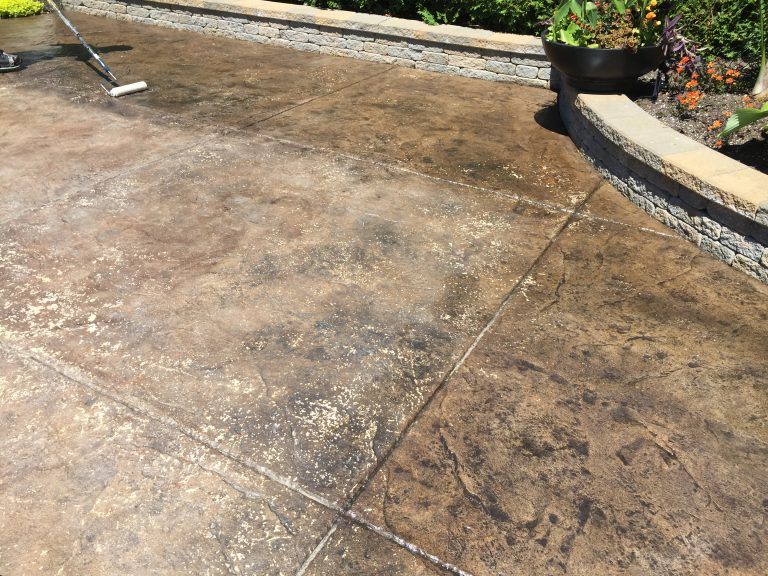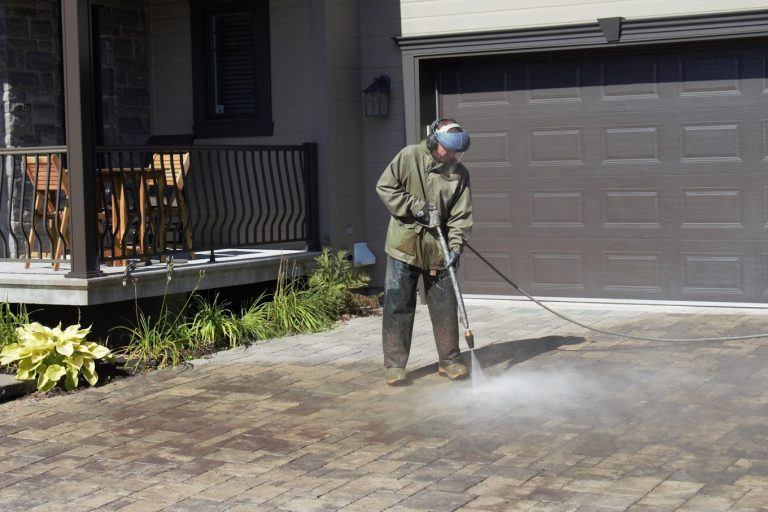What is a concrete sealer?
To keep your decorative or even plain concrete looking good for a long time, we strongly recommend sealing it with a high-quality concrete sealer. Once sealed, concrete will be protected from dirt, spills and weather, helping to prevent staining and reduce wear.
Sealing is particularly important in high-traffic commercial and industrial environments, as it will ensure that the surface can be easily maintained and will remain beautiful for a long time.
What is a concrete sealer?
A concrete sealer is a liquid solution used to protect and visually enhance concrete while increasing floor safety. It is applied to the concrete surface once it has hardened and been cleaned to form a protective layer.
There are two common types of sealant to choose from – film-forming sealants and penetrating sealants, each offering its own advantages and suitable for different applications.

Why do you need to seal your concrete floor?
The main reason for sealing concrete is to protect floors from damage such as abrasion, staining, freeze-thaw and salt attack. It’s essential to prevent liquids and chemicals from penetrating and damaging the concrete. Sealing will extend the life of the concrete, maintaining its functionality for longer.
Concrete sealer can also be used simply to embellish floors, increase gloss and improve color, especially for decorative concretes. Finally, sealers can be used to apply an anti-slip treatment to the floor, think of a wet concrete driveway or concrete pool deck.
What happens if you don’t seal the concrete?
If you don’t seal your concrete, you run the risk of encountering numerous problems. Remember that concrete is a very strong and durable material, but it remains porous. Concrete has capillaries and pores that allow dirt, mold, mildew and moisture to infiltrate.
Freeze-thaw attack is a major concern for unsealed concrete. Unsealed concrete exposed outdoors in cold climates is prone to water infiltration and ice formation. The dangerous thing to remember here is that when water freezes, it expands. This expansion can cause cracks, pits and chips, all of which will remain in the concrete when the ice melts. This freeze-thaw action is extremely damaging to concrete.
Trust the experts for your work
While some homeowners consider carrying out the project themselves, calling in a professional guarantees uniform application and minimizes the risk of costly mistakes. Trust Prostationnement for your renovations.
The different types of concrete sealers
There are two general categories of concrete sealants: surface sealants and penetrating sealants.
These categories include water-based and solvent-based sealants.
Which concrete sealants to choose?
Concrete sealants are either water-based or solvent-based, but there are a few key differences.
The purpose of a solvent in a sealer formulation is to act as a carrier for the sealer ingredients. The solvent dilutes the sealer and makes it easier to spread and penetrate the concrete when applied, leaving only the polymers on the surface when the solvent dissipates. The disadvantage of solvent-based sealants is that they are dangerous (flammable), have a strong odor and release harmful vapors into the environment. With advances in modern technology, we can now use water as a “solvent” for our concrete sealants instead of harmful chemicals.
There are many advantages to using a water-based sealer. The water itself is more environmentally friendly, but there are no flammability problems and much less odor, allowing the product to be used safely in indoor environments.
Surface sealants
Surface sealants create a protective layer on the concrete surface. They are generally applied after the concrete has been finished, hardened and cleaned. Here are some of the advantages of surface sealants:
- Improved appearance: They can enhance the color and shine of concrete, making them ideal for decorative concretes.
- Stain protection: They make concrete less porous, reducing the possibility of stains from spilled liquids.
- Ease of maintenance: They make cleaning easier by creating a smooth surface that prevents dirt and dust from becoming embedded.
- Abrasion resistance: They increase resistance to abrasion caused by foot and light vehicle traffic.
However, surface sealants can wear down over time, especially in high-traffic areas. They can also become slippery when wet, so it’s important to choose a sealer with a non-slip finish if necessary.
Penetrating sealants
Penetrating sealants are designed to penetrate the concrete surface and react chemically with the concrete components to form a waterproof gel. Here are just a few of the advantages of penetrating sealants:
- Water and liquid penetration protection: They effectively repel water and liquids, making them ideal for areas prone to dampness and seepage.
- Concrete breathing: They allow concrete to breathe, which means they don’t form a film on the surface or alter the appearance of the concrete.
- Freeze-thaw protection: They reduce the risk of freeze-thaw cracks by preventing water from penetrating the concrete.
However, penetrating sealers generally don’t improve the appearance of concrete, and they may not offer the same stain protection as surface sealers.

Which type of concrete sealer is best?
Choosing the best type of concrete sealer depends on the specific application and your needs. Here are a few tips to help you make your decision:
- If you want to improve the appearance of concrete, opt for a surface sealer. Be sure to choose a high-quality product to avoid fading and premature wear.
- If protection against stains and abrasion is your main concern, a surface sealer is also a good choice.
- For areas subject to moisture or infiltration, a penetrating sealer is generally preferable. It offers effective protection against water and does not alter the appearance of the concrete.
- If you need specific protection, such as an anti-slip finish, be sure to choose a sealer that meets these needs.
Ultimately, it’s advisable to consult a concrete professional or seek the advice of a concrete sealer expert to make sure you choose the right product for your project.
How long do concrete sealants last?
The service life of a concrete sealer depends on a number of factors, including product quality, application conditions, level of maintenance and the amount of traffic to which the surface is exposed. In general, surface sealants can last from 1 to 5 years, while penetrating sealants can last from 5 to 10 years or more.
It’s important to follow the manufacturer’s maintenance recommendations and reapply the sealer as needed to maintain the protection of the concrete surface.
Best practices for keeping concrete floors clean
To keep your concrete floors clean and in good condition, here are some best practices to follow :
- Sweep regularly to remove dirt and debris that can scratch the surface.
- Use a high-pressure cleaner to remove stubborn dirt and stains.
- Avoid using abrasive or corrosive chemicals that could damage the sealant.
- In the event of stains, clean immediately with a mild detergent and lukewarm water.
- Reapply sealant according to manufacturer’s recommendations to maintain effective protection.
Repairing and resealing a concrete surface
If your concrete surface shows signs of deterioration or if the sealant wears out, repairs and re-sealing may be necessary. Here are the general steps to follow for this process:
-
Cleaning: Start by thoroughly cleaning the concrete surface to remove any existing dirt, stains or sealant residues. High-pressure cleaning may be necessary.
-
Repair: Carry out any repairs required to correct cracks or imperfections in the concrete. You may need to fill cracks or holes with a suitable repair product.
-
Preparation: Prepare the surface for the type of sealer you will be using. Surface sealants often require sanding or polishing, while penetrating sealants require a clean, dry surface.
-
Application: Apply sealer according to manufacturer’s instructions. Be sure to work in appropriate conditions to allow proper drying and curing.
-
Maintenance: Follow the manufacturer’s maintenance recommendations and reapply sealant as needed to maintain protection.
It’s important to note that resealing and repairing concrete are tasks that can require special skills, and it’s often advisable to call in a professional to ensure optimum results.
Conclusion
In short, choosing the best concrete sealer depends on your specific needs and intended application. Be sure to choose a high-quality product and follow best maintenance practices to keep your concrete surfaces in good condition and protect them from the elements and daily wear and tear.
If necessary, consider calling in a professional for proper repairs and resealing.






